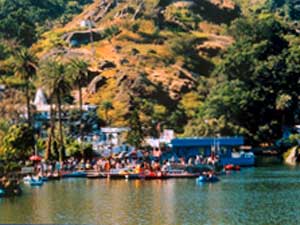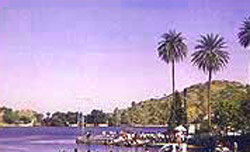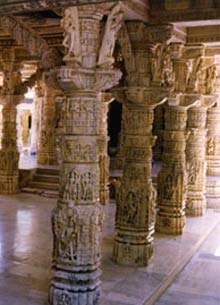| Destinations
|
|||||
What to see: Dilwara Temples: At a very short distance of 5 km lie these wonderfully carved Jain temples dating back to the 11th and 13th centuries A.D. Rated as among the finest of Indian temples, it is recommended that any visitor to Rajasthan include them on his itinerary. The marble architecture here is comparable with the best. Vimala - Vasahi Temple: This is the oldest temple in the complex, built in 1030 A.D. by Vimala Shah, a minister in the Government of Gujarat, to atone for his earthly sins. He dedicated it to Adinath, the first of the Jain tirthankaras, and the central shrine has an image of Adinath. The massive work involved in the temple took fourteen years to complete. The temple has been designed in an austere fashion on the outside but the ornateness strikes you immediately as you enter through the gateway.
|
More on Rajasthan • An Overview • Geography • People & Culture • Economy • Festivals • Wild Life • Adventure • Climate Cities • Ajmer Shareif • Alwar • Bharatpur • Bikaner • Chittaurgarh • Jaipur • Jaisalmer • Jodhpur • Kota • Ranakpur • Sariska • Udaipur
Travelogues
Impressions | ||||
 Neminath Temple: This was built in 1230 A.D. by two brothers, Vastupal and Tejpal, who dedicated it to Neminath, the 22nd tirthankara. It is told that gold and silver, equivalent in weight to that of the marble was given to the workers who worked on or sculpted the temple. Built in the Solanki style of architecture, the temple has a wonderful lotus flower piece hanging from the central dome in the porch. Shaped like a collection of half-open lotuses it is so exquisitely carved it has a translucent quality.
Neminath Temple: This was built in 1230 A.D. by two brothers, Vastupal and Tejpal, who dedicated it to Neminath, the 22nd tirthankara. It is told that gold and silver, equivalent in weight to that of the marble was given to the workers who worked on or sculpted the temple. Built in the Solanki style of architecture, the temple has a wonderful lotus flower piece hanging from the central dome in the porch. Shaped like a collection of half-open lotuses it is so exquisitely carved it has a translucent quality.
Luna Vashi Temple: Built in 1232 A.D., this temple is similar, but smaller than the Vimila -Vashi Temple. Its carved ornamentation is magnificent indeed. The doorways of the temples are framed by ornate pediments and plasters while the columns are exquisitely carved with the ceiling carved with mythological figures, dancers, horsemen and elephants. The masterpiece of the Dilwara complex is the ranga mandapa of the Luna- Vashi, with its superb ceiling, from the center of which hangs a clustered marble pendant. On a nearby frieze are sixty-eight dancers in different postures. There are two other temples in the complex, dedicated to Parshavantha and Adinatha.
Nakki Lake: The lake derives its name from the belief that it was gouged out of the earth by the fingernails (nakk) of the gods. The lake is the focal point of tourist activity in Mt. Abu. Boats are available for hire at reasonable rates.
Sunset Point: At a short distance from the lake, a spectacular view of the sunset can be witnessed here in quiet contemplation of nature. Gomukh Temple: Located about 2 Kms from Mount Abu, this is the site of the ancient agnikunda , where legend has it that sage Vashistha performed the great fire sacrifice. The temple contains an image of Vasistha along with images of Lord Rama and Lord Krishna, both of whom are considered to be incarnations of Vishnu, the Preserver of the Hindu trinity. The name Gomukh literally means cow's mouth, referring to a spring here which flows through the mouth of a marble cow. The spring water is believed to have sacred, purifying properties.
Guru Shikar: The peak of Guru Shikhar, at an altitude of 5,676 feet, is about 2 miles beyond Achalgarh and is the highest point in Rajasthan. It has a commanding view of Abu and its surroundings. Notable temples located here are the Mira Temple, Chaumundi Temple and a small Shaivite shrine. How to get thereThe nearest railway station is Abu Road, 27 km away, on the Delhi-Ahmedabad rail route. The bus-stand is adjacent to it, and buses are available from here, as well as from Mt Abu to all major towns in Rajasthan.
|
|||||
Editor: Romola Butalia (c) India Travelogue. All rights reserved. |
|||||


 Achalgarh Fort: This fort, built by the warrior King Rana Kumbha is now in ruins Five miles from Mount Abu, this is one of thirty-two forts that were constructed all over Mewar in order to secure the kingdom from invaders. Nearby are the remains of several ancient temples. Notable among these is the 15th century temple of Lord Shiva.
Achalgarh Fort: This fort, built by the warrior King Rana Kumbha is now in ruins Five miles from Mount Abu, this is one of thirty-two forts that were constructed all over Mewar in order to secure the kingdom from invaders. Nearby are the remains of several ancient temples. Notable among these is the 15th century temple of Lord Shiva.